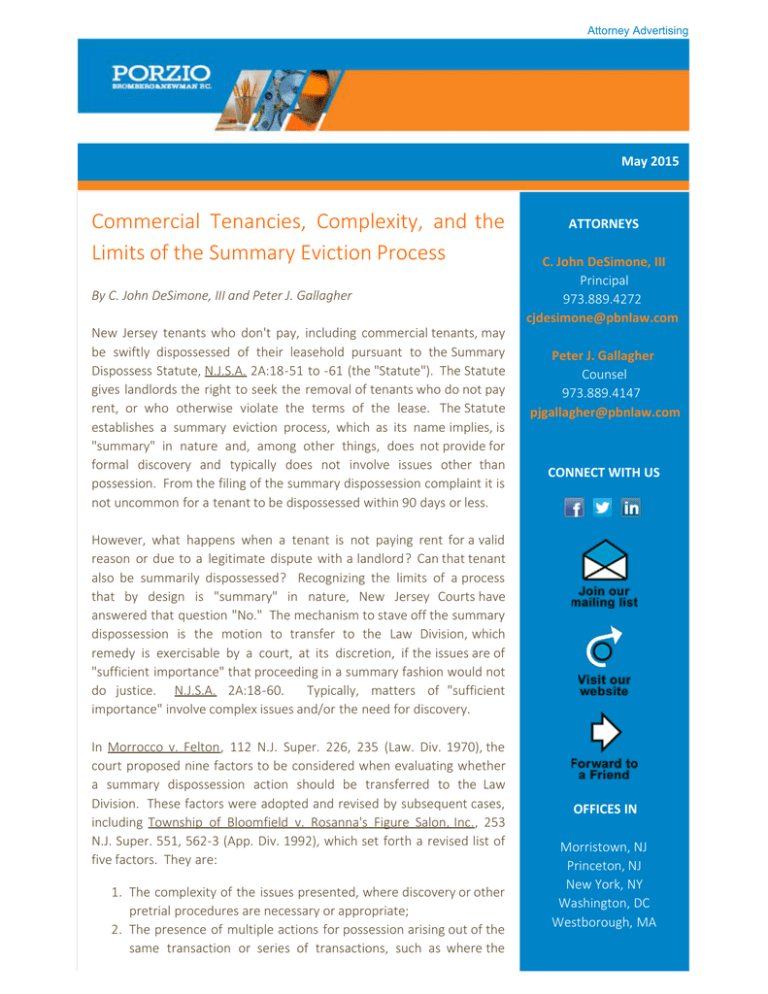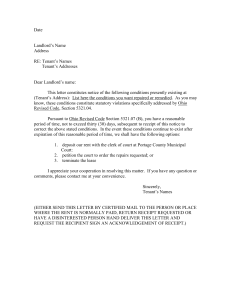
Attorney Advertising
May 2015
Commercial Tenancies, Complexity, and the
Limits of the Summary Eviction Process By C. John DeSimone, III and Peter J. Gallagher
New Jersey tenants who don't pay, including commercial tenants, may
be swiftly dispossessed of their leasehold pursuant to the Summary
Dispossess Statute, N.J.S.A. 2A:18-51 to -61 (the "Statute"). The Statute
gives landlords the right to seek the removal of tenants who do not pay
rent, or who otherwise violate the terms of the lease. The Statute
establishes a summary eviction process, which as its name implies, is
"summary" in nature and, among other things, does not provide for
formal discovery and typically does not involve issues other than
possession. From the filing of the summary dispossession complaint it is
not uncommon for a tenant to be dispossessed within 90 days or less.
However, what happens when a tenant is not paying rent for a valid
reason or due to a legitimate dispute with a landlord? Can that tenant
also be summarily dispossessed? Recognizing the limits of a process
that by design is "summary" in nature, New Jersey Courts have
answered that question "No." The mechanism to stave off the summary
dispossession is the motion to transfer to the Law Division, which
remedy is exercisable by a court, at its discretion, if the issues are of
"sufficient importance" that proceeding in a summary fashion would not
do justice. N.J.S.A. 2A:18-60. Typically, matters of "sufficient
importance" involve complex issues and/or the need for discovery.
In Morrocco v. Felton, 112 N.J. Super. 226, 235 (Law. Div. 1970), the
court proposed nine factors to be considered when evaluating whether
a summary dispossession action should be transferred to the Law
Division. These factors were adopted and revised by subsequent cases,
including Township of Bloomfield v. Rosanna's Figure Salon, Inc., 253
N.J. Super. 551, 562-3 (App. Div. 1992), which set forth a revised list of
five factors. They are:
1. The complexity of the issues presented, where discovery or other
pretrial procedures are necessary or appropriate;
2. The presence of multiple actions for possession arising out of the
same transaction or series of transactions, such as where the
ATTORNEYS
C. John DeSimone, III
Principal
973.889.4272 cjdesimone@pbnlaw.com Peter J. Gallagher Counsel
973.889.4147 pjgallagher@pbnlaw.com CONNECT WITH US
OFFICES IN
Morristown, NJ
Princeton, NJ
New York, NY
Washington, DC
Westborough, MA
dispossesses are based upon a concerted action by the tenants
involved;
3. The appropriateness of class relief;
4. The need for uniformity of result, such as where separate
proceedings are simultaneously pending in both the Superior
Court and the County District Court arising from the same
transaction or set of facts; and
5. The necessity of joining additional parties or claims in order to
reach a final result.
The Bloomfield court went on to summarize: In general, a motion for transfer should be granted whenever the procedural limitations
of a summary action (other than the unavailability of a jury trial) would significantly
prejudice substantial interests either of the litigants or of the judicial system itself, and,
because of the particular facts and circumstances of a specific case, those prejudicial
effects would outweigh the prejudice that would result from any delay caused by the
transfer.
Id. at 563.
Recently, in the first published opinion to pick up where Bloomfield left off, the Appellate Division in
Benjoray, Inc. v. Academy House Child Development Center, A-5162-12T3, approved for publication
October 16, 2014, relied upon the Bloomfield factors to reverse a lower court that had denied a
motion to transfer. In Benjoray, the tenant had withheld 15% of the rent when its architect calculated
the leasehold as being 15% smaller than it was supposed to be. The tenant argued that the rent it
agreed to pay in the lease was premised on the space being the size the lease said it was. The tenant
asserted it was damaged, arguing negligent misrepresentation on the part of the landlord as well as
breach of contract entitling it to rescission of the lease. The tenant offered to deposit the money
being withheld into court. The landlord argued the issues before the motion judge were not complex the tenant had agreed to pay a certain rent taking the property "as is," and the tenant was not paying
that rent. The landlord's architect disputed the tenant's square footage calculation, and in any event,
the landlord argued that the square footage set forth in the lease was only an approximation and that
if there was a discrepancy with the actual square footage, the space was generally consistent with the
lease figure.
The motion court agreed with the landlord, and denied the motion to transfer. On review, the
Appellate Division reversed, finding that the first Bloomfield factor applied insofar as the issues
presented were complex. The appellate court noted that the tenant's claims of negligent
misrepresentation and breach of contract were too complicated to be disposed of in a summary
dispossession hearing. Further, given the nature of the allegations the parties should be permitted to
conduct discovery. The appellate court went on to observe that the tenant had not merely asserted a
defense to the eviction action, but had also gone on to assert affirmative claims for breach of contract
and negligent misrepresentation, for which the tenant was seeking damages and rescission of the
lease.
The practical lessons of the above are clear. First, from the perspective of the landlord, if your tenant
has some colorable reason for not paying rent, then do not proceed to a summary dispossession
action presuming you will succeed. Do not let this misplaced presumption influence your decisionmaking and willingness to negotiate. Second, from the perspective of the tenant, if you perceive your
decision to withhold rent as being justified, be prepared to come into court with detailed proofs to
support your position. Consider asserting affirmative claims of your own, such as by way of separate
complaint in the Law Division, prior to, or contemporaneous with, seeking transfer of the summary
dispossession action. Successfully blocking a summary dispossession action via a motion to transfer
will likely continue to be the exception rather than the rule. Still, the option is available, and if the
merits are just, the motion to transfer may succeed.
***
John DeSimone (CJDeSimone@pbnlaw.com) and Pete Gallagher (PJGallagher@pbnlaw.com) are
attorneys at Porzio, Bromberg & Newman, P.C. (www.pbnlaw.com), a full service law firm with offices
in Morristown and Princeton, New Jersey, New York City, Washington D.C., and Westborough,
Massachusetts. John and Pete practice commercial and real estate litigation and can be reached at
973-538-4006.
©Copyright 2014 Porzio, Bromberg Newman P.C. All Rights Reserved | 973-538-4006 | www.pbnlaw.com


![[DATE] [LANDLORD’S NAME] [LANDLORS’S ADDRESS 1]](http://s2.studylib.net/store/data/015209382_1-43f6f34dffd5b41b97d8eef24e65816c-300x300.png)

